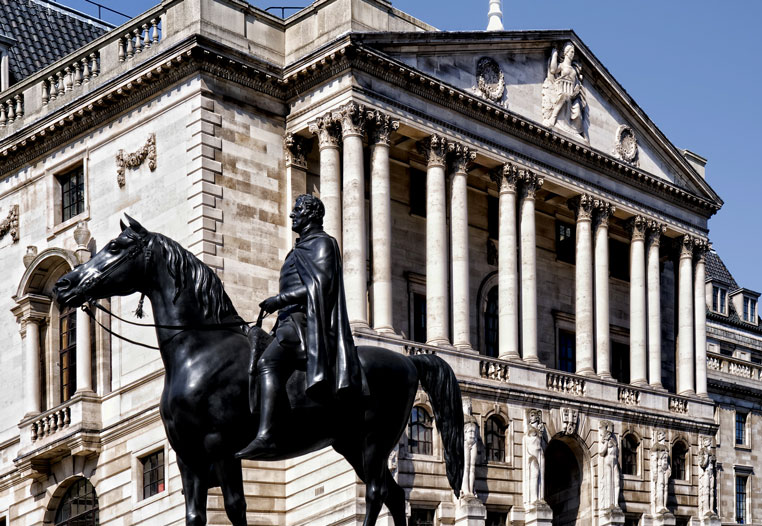The UK Bank Rate was held at 0.25%, government bond purchases at £435bn and corporate bond purchases at up to £10bn. Inflation remains well below target and business investment weak.
The Bank of England’s Monetary Policy Committee (MPC) sets monetary policy to meet the 2% inflation target and in a way that helps to sustain growth and employment. At its meeting ending on 14 September 2016, the MPC voted unanimously to maintain Bank Rate at 0.25%. The Committee voted unanimously to continue with the programme of sterling non-financial investment-grade corporate bond purchases totalling up to £10 billion, financed by the issuance of central bank reserves. The Committee also voted unanimously to continue with the programme of £60 billion of UK government bond purchases to take the total stock of these purchases to £435 billion, financed by the issuance of central bank reserves.
The package of measures announced by the Committee at its August meeting led to a greater than anticipated boost to UK asset prices. Short and long-term market interest rates fell notably following the announcement; corporate bond spreads narrowed, and issuance was strong; and equity prices rose. Since then, some of the falls in yields have reversed, driven by somewhat stronger-than-expected UK data and a generalised rise in global yields.
Many banks announced cuts in Standard Variable Rate and Tracker mortgage rates in line with the cut in Bank Rate. Deposit rates fell in August, although on average these falls were slightly smaller than the cut in Bank Rate. Fixed rates on new mortgage lending also fell.
Overall, while the evidence on the initial impact of the policy package is encouraging, the Committee will monitor closely changes in asset prices and in interest rates facing households and firms and their effect on economic activity.
The MPC set out its most recent detailed assessment of the economic outlook in the August Inflation Report. Based on the data available at that time, the Committee judged that the UK economy was likely to see little growth in the second half of 2016. In light of the tendency for survey indicators to overreact to unexpected events, the Committee expected some bounce-back in surveys of business and consumer sentiment following the sharp falls in the immediate aftermath of the vote to leave the European Union. Nevertheless, since the August Inflation Report, a number of indicators of near-term economic activity have been somewhat stronger than expected. The Committee now expect less of a slowing in UK GDP growth in the second half of 2016.
It was more difficult to draw a strong inference from these data about the Committee’s projections for 2017 and beyond. Moreover, there had been no new information since the August Inflation Report relevant for longer-term prospects for the UK economy.
In the August Inflation Report, the Committee judged that some parts of the economy would be more sensitive than others to heightened uncertainty. Business and housing investment were expected to decline in the second half of 2016, while consumption growth was expected to slow more gradually, alongside households’ real disposable incomes. While most business investment intentions surveys weakened further since the August Inflation Report, the near-term outlook for the housing market is less negative than expected and the indicators of consumption have been a little stronger than expected. Overall, these data remain consistent with the Committee’s judgement in the August Inflation Report that business spending would slow more sharply than consumer spending in response to the uncertainty associated with the United Kingdom’s vote to leave the European Union.
Data on global economic activity have generally been in line with the Committee’s August Inflation Report projections, with growth in the United Kingdom’s major trading partners expected to continue at a modest pace over the next three years.
Twelve-month CPI inflation remained at 0.6% in August, lower than projected at the time of the August Inflation Report, and well below the 2% inflation target. As the unusually large drags from energy and food prices attenuate, CPI inflation is expected to rise to around its 2% target in the first half of 2017, consistent with the August Inflation Report, albeit with the projection a little lower over the remainder of 2016 than had been anticipated in August.
The Committee’s view of the contours of the economic outlook following the EU referendum had not changed. News on the near-term momentum of the UK economy had, however, been slightly to the upside relative to the August Inflation Report projections. The Committee will assess that news, along with other forthcoming indicators, during its November forecast round. If, in light of that full updated assessment, the outlook at that time is judged to be broadly consistent with the August Inflation Report projections, a majority of members expect to support a further cut in Bank Rate to its effective lower bound at one of the MPC’s forthcoming meetings during the course of this year. The MPC currently judges this bound to be close to, but a little above, zero.
Against that backdrop, at its meeting ending on 14 September, MPC members judged it appropriate to leave the stance of monetary policy unchanged.

